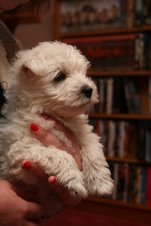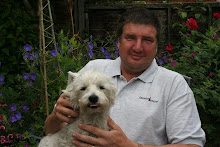 |
Honey bee on swede/turnip flower. I left the last half dozen
to run away to seed and the bees love them. |
Bad weather, strong winds and heavy showers have kept us a bit pinned down of late. I have to admit to having got badly behind on the gardening. It has been fairly warm, so the weeds have charged onwards even when it's been too wet to get out and tackle them, so I have ground still needing clearing before I can plant things, and seeds still sitting here in packets which should have been in the ground long ago. Any big projects have been parked for the moment and we have been snatching opportunities to do little jobs in the sunny intervals. These have mainly been livestock, so this post will be a bit of a livestock update.
 |
Our bees on our apple blossom. We are delighted with this
'first' for Feigh. |
The biggest news is that we finally got a chance to crack open the bee hive and were quickly able to establish that we had larvae in the brood frames which told us immediately that the Queen Bee must still be alive. This was a huge relief as we were worried that we might have squashed her in our clumsy, amateurish efforts to re-hive the donated colony. This would have been serious and embarrassing. To lose one colony in a year, as they might say, is unfortunate.... but to lose two...... But no, it is now 25 days since our re-hiving, so any eggs laid by the queen prior to that would have long since completed their larval stage, pupated and even emerged as adults. We are happy bee keepers.
 |
| The swarm-box is strapped to the big ash tree, top right. |
At this time of year, beekeepers start to think about swarming, potentially losing their queen and half the work force, possibly catching them or, even better, bribing someone else's absconded colony to fetch up and stay at your apiary. We have our swarm-box strapped to the ash tree but this year, anyway, it is unlikely to catch any prime-swarm of ours. Our queen, we know has been wing-clipped as well as colour-marked, so if our workers decide to swarm, they would boot her out of the colony but then instead of flying off with them to hang in a tree, she will fall to the ground and probably get lost in the grass.
 |
| Colour codes for queen-marking. |
Some bee keepers do this to try to stop the swarm taking off (the idea is that they realise they have lost Her Majesty and return to the hive). If we are lucky she will gather a small number of workers around her on the ground which we might spot and be able to rescue into the skep, where we can then gather some of the swarm or some workers from the hive to make up a new colony. It's a long shot. You have to hope that the swarm only leaves the hive when it has set up replacement queens ready to emerge from their own pupae and that these (virgin) queens get successfully mated on their mating-flights before returning to the hive to carry on the good work.
 |
| Poppea talks to Mary through the fence while Towser watches |
Meanwhile, in the pigs dept, our two young ladies have reached the 3-month-old mark. They are thriving, very strong in the appetite area and now grown bigger than the dogs by quite a way. We are very happy with them. They have also become quite tame by now and allow me to measure them with the tape measure (see earlier post) to estimate weights. They seem to be about 17 kgs, possibly a bit smaller than last year's Tamworths but we did not manage to measure those till they were a bit older. I am being a bit more careful to control food intake on these girls as we are aiming for a carcass with a bit less fat covering. They also seem to be a lot more into rootling and churning up the ground, but again, when we got the Tams the ground was dry and hard for their first month, where these animals have had plenty of rain and easy-peel turf.
 |
The Hubbards at 3 weeks feel some first sun on their feathers
and grass under their feet |
The Hubbard chicks are cracking on too and have quickly out grown the bodged-up brooder box (made from 2 big potato crisp box 'outers') we have them in upstairs in the spare room. Luckily the weather has turned nicely warm, so we have been letting them out in the sunshine in one of the rabbit runs, all be it with one end well wrapped against the rather chilly breezes and a good layer of shredded wood and hay in the 'bedroom'. They are also just outside the front window where Liz can keep a close eye out for any signs of chilling - there have been none - the birds race about happily chasing each other, scratching for food among the grass and doing some practise play-fights as they set up their pecking order.
 |
The old tumble-down apple tree is in full bloom. It never
ceases to amaze me. It looks almost rotted through at the
broken base but there must be just enough intact sap-wood
to keep it going. |
We rescue them back indoors at night for now, but will soon be letting them do a 'sleep over' in the rabbit run. They are only 3 weeks old tomorrow but these are no ordinary 'little cute fluffy chicks', they grow and put in weight like no other bird we have met. I should probably weigh some tomorrow but in the commercial world these guys make oven-ready weights in 80 to 100 days. It will take longer in our free range set-up - we normally give them 4-5 months. At 6 weeks we usually let them start to explore properly by lifting the end of their run in the morning so that they can escape, and then, for a while, we chase them all back home with a food bribe in the evening. They may voluntarily start to use the proper chicken coop.
 |
| New ear tags for the twins. |
Also cracking on are the twin lambs, who made their 6-week birthday on the 7th May. This means that they need to get ear tagged, so we had some fun rounding all 5 sheep up into the cattle race so that we could tag these and check everyone's feet, trim and spray if necessary. No foot problems this time, so with Louise now officially (IE0455809)00002H and Thelma 00003A we are all legal and booked into my paperwork. You don't tag till 6 weeks because the ears would be so tiny and the tag so huge compared to the ear, it would be uncomfortable for the lamb and there is a risk of nicking a blood vessel. Hulking 6-weekers have their blood vessels nicely spaced apart on acres of ear - you can aim more reliably with the pliers.
 |
Turkey eggs in the borrowed incubator
(many thanks, Charlotte!) |
The new turkeys did not miss a beat on their egg laying with the move here, so we were able to give the half dozen asked for by a possible new friend of ours requested by Charlotte. This is a lady with a tup (ram) who we may be able to use come August, to service our Polly and Lily (plus one?) so we are looking to schmooze her up a bit, with turkey and Buff Orp eggs as the main bribe currency. Our turkey hen, though, Barbara carried on a-laying, happily joining in with the chickens' current habit of dropping the eggs in the known stash under the elderberry tree in the woods, but also (once) on the nest of the broody Buff in the Tígín. We decided that we might as well incubate a few of these just to see how we get on. We borrowed Charlotte's incubator again (Thanks C) and have set 8 in it. They take 28 days to cook, so are due on 8th June.
 |
(Top to bottom) Chestnut, soapwort,
lemon balm, sweet woodruff and
comfrey in the nursery area |
That broody Buff has stuck with the job tucked down between the concrete blocks and the camping toilet and is almost there now, with the 'proper' eggs due in 2 more day's time. 'Proper'? Yes, we were rather horrified to see on Sunday that she had left the nest and there was 'now' a white Hubbard adult hen sitting there, presumably laying an extra egg. Moments later Miss White was off and cackling and the broody Buff had nipped back in, so we could not see if there were extras. The next day we caught them again and discovered that Miss Buff was now sitting on 13 eggs (!), 7 more than we'd set under her and one of these the aforementioned turkey egg. We recovered that one.
 |
| Cheese and bacon 'swiss' rolls. |
You do not have to be a chicken expert to see that these eggs have turned up at some unknown time between our true start-date (April 24th) and now, so will only be part-incubated by our Day 21 (Thursday). When (if) the 'proper' six chicks hatch and start to get active, Miss Buff will abandon the nest and take them off to play, leaving the unhatched eggs as failures to go cold. We have an option, if we see the move and can rescue the eggs still warm, to nip them into the incubator but that way madness lies. You end up with baby chicks of all ages moving through the rearing processes not necessarily compatible with each other (size differences etc). It is not going to be dull, anyway! We have, meanwhile, closed the Tígín door on the broody. She can do her last few days without interference from her 'sisters' and sitting just on the existing eggs. And yes, we could have marked the original 6 eggs, but hey, that would have been way too sensible.
 |
| Dunhills all? The gang on the calf-muck heap. |
That about wraps it up for this one, with most of the livestock covered. The rabbits have not had a mention but they are just mooching along calmly enjoying their big new run. The dogs and cats are just the dogs and cats. No news is good news.














No comments:
Post a Comment